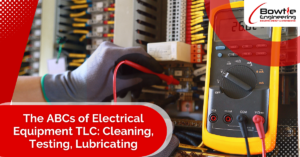BENEFITS OF READING THIS BLOG
- Extend Equipment Lifespan: Discover how proper TLC (Cleaning, Testing, Lubricating) can significantly prolong the life of your electrical equipment.
- Enhanced Safety: Learn maintenance techniques that reduce the risk of electrical malfunctions and accidents, ensuring a safer environment.
- Cost Savings: Understand how regular TLC can help you avoid costly repairs and replacements, ultimately saving you money.
- Improved Performance: Find out how a well-maintained electrical system operates more efficiently, leading to enhanced performance.
- Environmental Responsibility: Explore eco-friendly TLC practices that contribute to sustainability.
- Expert Insights: Benefit from professional tips and industry best practices shared by Bowtie Engineering’s experts.
Introduction
Electrical equipment surrounds us in our daily lives. From the appliances in our homes to the intricate machinery in industries, electricity powers our modern world. However, like any other mechanical system, electrical equipment requires regular care and attention to function optimally. Neglecting maintenance not only reduces efficiency but can also lead to costly breakdowns or even safety hazards.
This blog will guide you through the ABCs of Electrical Equipment TLC: Cleaning, Testing, and Lubricating. We’ll explore the benefits of these practices, discuss essential techniques, and offer expert insights to empower you to take control of your electrical systems.
Importance of Electrical Equipment TLC
Maintaining electrical equipment isn’t just about making it look clean; it’s about ensuring safety, efficiency, and longevity. Here’s why it’s crucial:
Safety: Faulty electrical equipment is a significant fire hazard and can cause electrocutions. Regular TLC helps identify and rectify potential safety issues.
Longevity: Electrical equipment isn’t cheap. Proper maintenance can significantly extend its lifespan, saving you money in the long run.
Efficiency: Well-maintained equipment operates more efficiently, reducing energy consumption and associated costs.
Downtime Reduction: Scheduled maintenance can be planned, reducing unexpected downtime in both homes and industries.
Now, let’s dive into the ABCs of Electrical Equipment TLC.
Cleaning Techniques
A. Tools and Materials
Before you embark on cleaning your electrical equipment, gather the necessary tools and materials. These might include:
Soft, lint-free cloths
Cleaning solutions recommended for electrical equipment
Compressed air canisters
Brushes with anti-static bristles
Safety gear such as gloves and safety goggles
B. Step-by-step Cleaning Process
Power Off:
Always turn off the electrical equipment and unplug it from the power source before cleaning. Safety first!
Dust Removal:
Use compressed air to blow away dust and debris from the equipment’s surfaces. This should be done regularly, as dust accumulation can lead to overheating.
Surface Cleaning:
Dampen a lint-free cloth with a suitable cleaning solution, and gently wipe down the exterior of the equipment. Be cautious not to let any liquid seep into the equipment.
Interior Cleaning:
If it’s safe to do so, open the equipment (following manufacturer guidelines) and carefully clean the interior. Pay special attention to fans and vents, as these are prone to dust buildup.
Connections and Contacts:
Check and clean any connectors or contacts, ensuring a secure and efficient electrical connection.
Reassembly:
If you’ve opened the equipment, reassemble it according to the manufacturer’s instructions.
Testing Procedures
A. Why Testing is Crucial
Testing your electrical equipment is like giving it a health check-up. It helps detect problems before they become disasters. Here’s why testing is crucial:
Early Problem Detection: Testing can reveal underlying issues that might not be apparent during visual inspection.
Compliance: In some industries, regular equipment testing is a legal requirement to ensure compliance with safety regulations.
Reliability: Testing ensures that equipment performs as expected, reducing the risk of unexpected failures.
B. Recommended Testing Tools
The specific tools you need for testing may vary depending on the type of equipment, but some common tools include:
Multimeter: Measures voltage, current, and resistance.
Insulation Resistance Tester: Checks the insulation integrity of wires and components.
Circuit Tester: Detects the presence of voltage in electrical circuits.
Ground Resistance Tester: Ensures proper grounding, crucial for safety.
Oscilloscope: Used for more advanced diagnostics.
C. How to Interpret Test Results
Voltage and Current: Ensure that voltage and current measurements are within the equipment’s specified range. Deviations may indicate electrical problems.
Insulation Resistance: High resistance can indicate insulation breakdown, while low resistance can indicate a short circuit. These issues need immediate attention.
Grounding: Proper grounding is vital for safety. Test ground resistance regularly and maintain it within safe limits.
Lubrication Guidelines
A. Types of Lubricants
Choosing the right lubricant is essential for the longevity and performance of your electrical equipment. Common lubricants include:
Silicone-based lubricants: Ideal for plastic and rubber parts, they are non-conductive and have good temperature stability.
White lithium grease: Effective for metal-to-metal and metal-to-plastic applications, it’s resistant to moisture and corrosion.
Graphite lubricants: Suitable for high-temperature applications, they provide excellent dry lubrication.
Dielectric grease: Specifically designed for electrical connections, it prevents corrosion and maintains conductivity.
B. Where to Apply Lubrication
Bearings: Lubricate bearings regularly to reduce friction and wear.
Moving Parts: Apply lubricant to any moving parts, such as gears and sliding mechanisms.
Electrical Contacts: Use dielectric grease or special contact lubricants to maintain good electrical conductivity in connectors.
Threaded Connections: Apply a small amount of anti-seize compound to threaded connections to prevent them from seizing up due to corrosion.
Maintenance Schedules
Creating a maintenance schedule is essential for ensuring that TLC for your electrical equipment remains consistent and effective. The frequency of maintenance depends on the type of equipment and its usage. Here are some general guidelines:
Daily Checks: For critical equipment or applications, a daily visual check can be beneficial. Look for signs of damage or abnormal operation.
Weekly or Monthly Maintenance: This includes dusting and cleaning, especially in industrial settings with high dust levels.
Quarterly or Bi-annual Maintenance: Perform more thorough cleaning, testing, and lubrication as needed.
Annual Maintenance: For critical equipment, consider a comprehensive annual maintenance schedule that includes a complete inspection, testing, and possible replacement of parts.
Always refer to the manufacturer’s guidelines for specific maintenance recommendations, as they may vary by brand and equipment type.
Safety Measures
Safety should be your top priority when performing TLC on electrical equipment. Here are some essential safety measures to follow:
Power Down: Always turn off and unplug electrical equipment before maintenance.
Personal Protective Equipment (PPE): Wear appropriate PPE, including gloves, safety goggles, and insulated tools when necessary.
Training: Ensure that anyone performing maintenance is trained and competent in electrical safety procedures.
Lockout-Tagout (LOTO): In industrial settings, use LOTO procedures to prevent accidental energization of equipment.
Isolation: Isolate equipment from power sources and lock or tag out switches and circuits.
Ventilation: In enclosed spaces, ensure proper ventilation to disperse any fumes from cleaning products or lubricants.
Environmental Considerations
As we maintain our electrical equipment, let’s also consider the environment. Here are some eco-friendly practices:
Product Selection: Choose environmentally friendly cleaning solutions and lubricants.
Waste Disposal: Dispose of used cleaning materials and lubricants responsibly, following local regulations.
Energy Efficiency: Regular maintenance helps equipment operate efficiently, reducing energy consumption and your carbon footprint.
Conclusion
In conclusion, the ABCs of Electrical Equipment TLC – Cleaning, Testing, and Lubricating – are essential practices for ensuring the safety, reliability, and longevity of your electrical equipment. Neglecting these maintenance steps can lead to costly repairs, downtime, and safety hazards. By following the guidelines outlined in this blog, you can take proactive steps to keep your electrical equipment in top-notch condition.
Remember, safety should always be your primary concern when working with electrical equipment. When in doubt, consult the manufacturer’s guidelines or seek professional assistance. Regular TLC will not only save you money in the long run but also contribute to a safer and more sustainable future.
 Skip to content
Skip to content 
